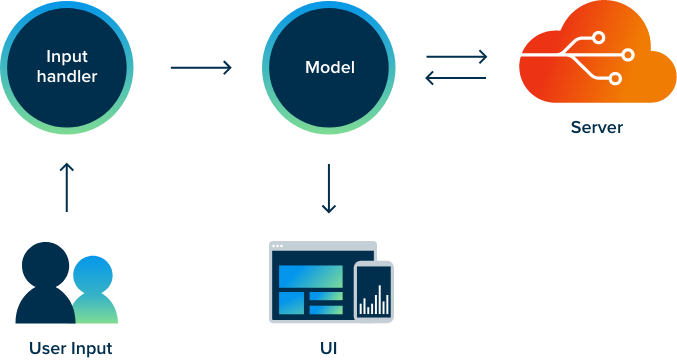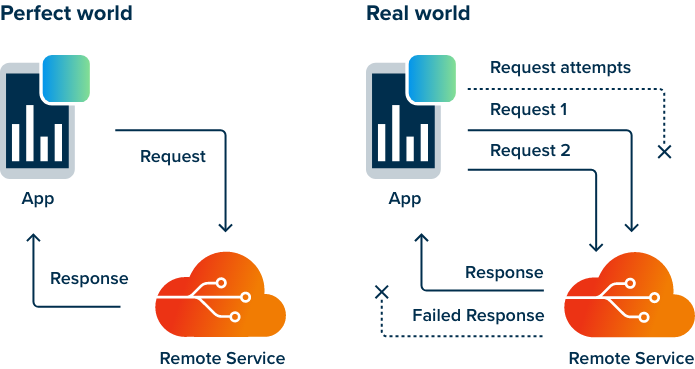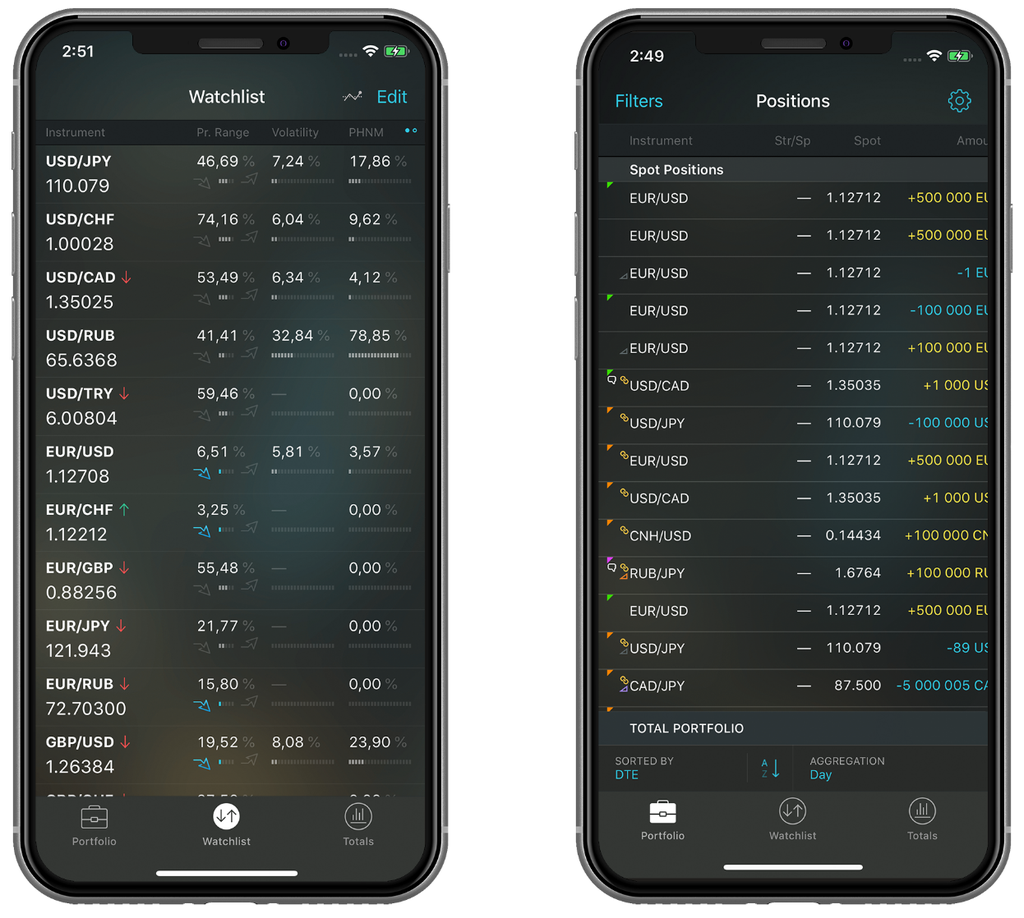How to Build a Mobile Trading App
Our 4 Keystones of Mobile App Development
It’s safe to say we’ve done it all: our financial mobile development experience started from software for the now outdated BlackBerry and Pocket PC, alongside mobile web, which included time-worn WAP, and then we transitioned to iOS and Android development, settling on them for now. Here we will reflect upon these experiences which shaped our four keystones of mobile development and brought our software to the top of its game.

1st Keystone: Code Reuse and its Perks
Today, most mobile apps are available on multiple platforms, challenging developers and compelling them to cut the amount of codebases. The less codebases we have, the cheaper and faster it is to support the whole solution and update it with new functions. We want to reuse one general code as much as possible.
One of the most popular answers to this challenge is having one codebase and adapting it with a cross-platform UI engine. There are two common methods for accomplishing this goal.
The first one is developing a hybrid app. In this method, base material for a “native” application is a website’s mobile version, which is inserted into a platform native framework to imitate the native code. There are dozens of hybrid frameworks available, the most notable ones are PhoneGap, Ionic, Framework 7, and Mobile Angular UI.

The second method is to use full-fledged cross-platform frameworks, such as React Native, Xamarin, and Flutter. Such frameworks are more native than those used in the first method, each of them requires a code in a specific language (JavaScript, C#, Dart, etc.) inserted into a framework that generates a real native code for supported mobile platforms.

Unfortunately, these methods for reusing code have several common issues specific to the technology, and we had a chance to see them for
The stumbling point when using frameworks is a drastic difference in visual and behavioral aspects of mobile platforms: design languages, navigation (e.g. back button in Android and lack of it in iOS), interaction, and animation. Applying them makes applications look unfamiliar and broken. These frameworks give us very slow, unstable and hard to support results due to required integration with
Another method used in mobile development is a thin client. Here we minimize

At some point, we researched ways to reuse the code without the methods described above, because we faced the challenge of making a mobile version of one of our desktop products, and these ways could not cope with the task. That’s how we came up with the idea of code translation without reusing UI, the part responsible for the platform’s specifics. Instead, we apply

Lots of software developers actively seek solutions for code reuse among platforms, and there are definitely other approaches besides j2Objc and cross-platform frameworks. After Kotlin became overwhelmingly popular, especially in mobile development, its authors from JetBrains went even further by proposing a Kotlin/Native instrument, which applies modern language code to a server-side, mobile app, and web. This kind of technology is not perfect yet – it has some adverse beginnings, but there is a great chance that soon enough they will be adequately stable for a wider audience.
Considering all methods of cross-platform development, we advocate for reusing the code as much as possible via code translation and multi-platform languages, keeping in mind that all kinds of hybrid approaches do not work in the long run for
high quality apps.
If you aim for a complex quality app, it is more likely that sooner or later you will have to rewrite it with
In the mobile world, there is a competition defined by user requirements and needs. Mobile apps must be familiar, easy-to-use, and responsive: users prefer working with comfortable
2nd Keystone: Networking in Mobile Development — We Need to Find the Right Solution
Networking is a tricky issue due to frequently slow and unreliable connections to servers. In the perfect world of mobile networking, an app sends a request to a remote service and gets a response – it is as simple as that. In the real world, an app makes several request attempts to a remote service, and often not all of these attempts are successful. So when it comes to working on interactions with a server, a majority of developers choose either the easiest and most direct solution, or some industry standard. It’s not always for the better, particularly when an application works with a stream of rapidly changing data (market data, to be precise). It is critical for an application to display data updates quickly and often. Moreover, it’s unacceptable for an application with dynamic data to display a message “Please try again” when the loading of data is interrupted, which is quite common in the mobile world.

In our scope, these challenges are very real, and we need to be responsible for them. If we analyze a particular use case and data set, we can learn to transfer them cost-effectively or to make connectivity breaks invisible to a user. Moreover, we want to make responsible transport code for solutions of these issues, and the code of the application itself would work at the level of “send data – receive data” without manually solving each case. We haven’t considered text protocols as a transport method because we opt for speedy and frequent deliveries. So we developed our own transport framework MOBTR. It is a binary protocol that considers all known specifics of our data. We were able to optimize work with the network exactly for our special case currently used in the development of trading frontends.

Our solution doesn’t necessarily suit everybody and doesn’t have to be in demand by everybody. It’s about conducting such analysis and choosing relevant instruments.
Optimization of data traffic helps a lot in terms of slow and unstable connections. We suggest optimizing this process by transferring only delta of numbers (obtained through subtraction). Trading apps are convenient in that line. Quotes don’t drastically change, usually only one or two of their decimals do, so subtraction works perfectly for optimization, because we need to transfer smaller values.
Optimizing data transfer for mobile is not a one-fits-all approach. In case of frequent data updates, go binary. If you need more performance, go data aware, find a way to minimize the transferred values. In case of specific requirements, go custom and develop or adapt a transport framework according to them.
There are two great examples of messengers that used different approaches: Telegram and Whatsapp. Whatsapp chose a usual way for startups: it was developed to work with a standard protocol, and its performance is close to
3d Keystone: Staying on a Bleeding Edge
Things tend to change. Devices change a lot, and they do it fast. Today mobile phones can do what computers couldn’t 10 years ago, and smartwatches can do what phones couldn’t 5 years ago. Staying on the bleeding edge with such speedy changes is hard, and some choose the wrong way to act (or fail to act at all). Here are two dud approaches, if you don’t want to keep ahead of the game.
- Keeping things old school. It’s easy and stable, which makes it almost impossible to go wrong, except you get no evolution at all. Development teams utilizing this method produce apps with zero response to
environment and no room for growth. On top of that, they spend more time on maintenance than anyone in the industry. - Being modern and using all the frameworks on GitHub! You will spend a nice long time making it all work together, managing your dependencies, and optimizing the binary size.
Before doing all that, just watch The Silver Bullet Syndrome by Hadi Hariri to make things easier. Spoiler alert: there is no silver bullet in software development, but there are approaches that will make things work in terms of staying on the bleeding edge:
- Don’t drag your feet. Somebody will outrun you and make it better and faster.
- Don’t rush. We can drown in
latest trends, and it will make the code more complex, and its development will be harder. At the sametime these modernization efforts don’t pay off.
What should we do? We need to find a balance. We need to track what’s going on with the technology and experiment accordingly.
We also need to introduce something modern to our solutions only when we have answers to the following questions:
- What does it bring to this particular project?
- What will it cost us?
A common mistake is to search for
solution in an instrument. In most cases, it is not about programming language and not an item in a library (although it happens sometimes), but in the code itself, its architecture
Gradually we actualize the code by applying everything that can be useful. At the same time we move evolutionary, not revolutionary: we’re not rushing to rewrite all applications to a new language from scratch as soon as it starts getting popular.
For example, we use the latest versions of j2objc, Swift, and Kotlin in our work, where it’s relevant and doesn’t ruin everything.

4th Keystone: No F5 in Mobile Development
It’s an important feature of mobile development that is usually omitted. In web development, you can change the code, then refresh a page, and a client will get the newest version.
It doesn’t work this way with mobile applications. There is no physical possibility to remove the code of an installed application. You can forbid an application to connect to your server, but it’s beyond the borderline of developers’ decency. That’s why we need to understand that the written client code can live a long life and we must develop its best version possible.
What should we do? We should pay particular attention to client-side code and think about backward compatibility.
Down the line, our years of mobile development have shaped four keystones that optimize it to the max:
- Reusing code as much as possible
- Analyzing the transmitted data and finding a suitable solution
- Avoiding going too slow and breaking the speed of light at the same time
- There is no F5 in mobile: once written, the client-side code is here to stay
How do you deal with the code reuse challenges?
What methods of cross-platform development do you deem fit for financial software?